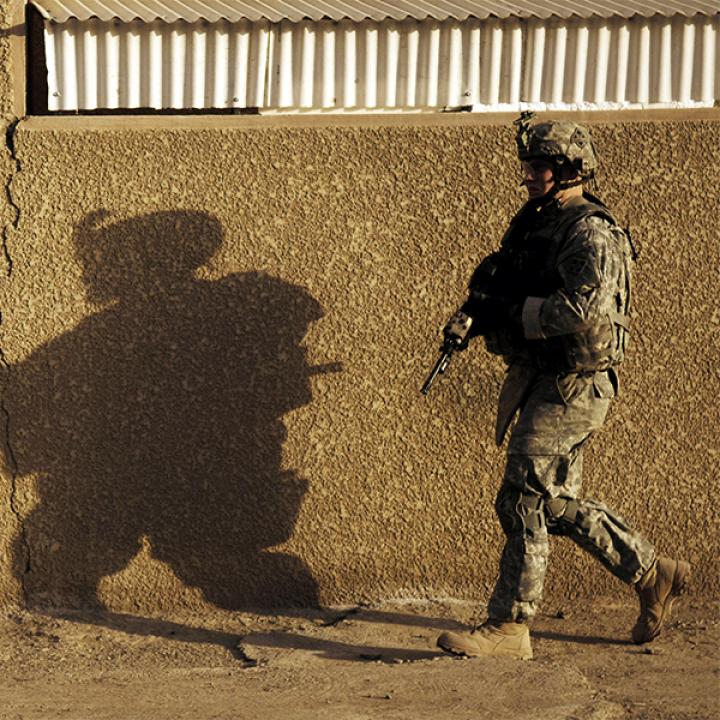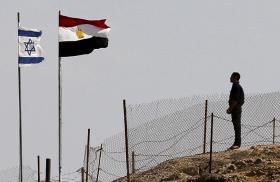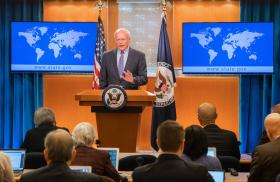
- Policy Analysis
- PolicyWatch 4110
After Operation Inherent Resolve: The Future of U.S.-Iraq Security Relations

Whether Washington opts for complete withdrawal, a smaller, Kurdistan-based presence, or a 180-degree shift to business and energy initiatives, it needs to be mindful of the risks and keep the focus on America’s paramount strategic interests.
This month marks the formal conclusion of Operation Inherent Resolve (OIR), the mission that the Obama administration and its international coalition partners originally launched in 2014 to roll back the Islamic State (IS) offensive in Iraq. In practical terms, the final steps to end the mission remain unclear for now, but the working assumption is that all remaining U.S. troops will definitively depart Iraq by the end of 2026, raising questions about the future of bilateral relations and the residual IS threat. Despite differences over Iran’s role in Iraq and other issues, Washington and Baghdad both seek closer relations, including a security component. But how should that component be organized in light of impending withdrawals?
Shifting Missions, Perspectives, and Threats
After deploying to Iraq (and later Syria) a decade ago, the OIR coalition dismantled much of the Islamic State’s territorial control, rebuilt elements of Iraq’s security apparatus, and restored stability. By 2017, major combat operations against IS ended, so the coalition refocused on working with Iraqi and Syrian partners to fight the organization’s remnants and continue stabilizing affected populations.
Last September, the Biden administration announced that OIR would formally conclude in Iraq within a year, framing the approach as a two-part “transition” rather than a withdrawal. This plan was to take place in two phases: first, closing coalition military sites in Iraq by September 2025; second, retaining a partial, unilateral U.S. presence in Iraq “at least through 2026” to support anti-IS operations next door in Syria. The plan left substantial room for maneuverability, though scores of Iraqi militia attacks on U.S. forces influenced the administration’s desire to set a deadline and expedite the withdrawal.
As OIR’s mission shifted, developments in Baghdad steadily slipped off Washington’s front pages, with Iraq policy often treated as an afterthought to broader Iran strategy. Today, some U.S. officials argue that a full withdrawal would risk repeating the “deploy, withdraw, rush back” cycle, but others see little justification for an open-ended presence. The Trump administration’s deep spending cuts across the government raise additional uncertainties, particularly regarding how the counter-IS mission and other crucial U.S. efforts will be funded in the long term.
Meanwhile, Baghdad has its own balancing act to worry about. Iraqi leaders see the end of OIR as a chance to reclaim “full” sovereignty, diversify their relationships with other foreign powers, and attract investment from abroad. Yet each of these goals is complicated by the entrenched influence of Iran-backed groups and individuals—many of them U.S.-designated terrorist entities—who dominate the Popular Mobilization Forces (PMF). The challenge for Baghdad is how to redefine ties with the United States beyond the battlefield while avoiding American perceptions that it is an Iranian proxy, not to mention domestic perceptions that it is kowtowing to Washington.
President Trump himself apparently prefers complete withdrawal (similar to his first-term goals in Syria) and has repeatedly stoked domestic backlash against “forever wars,” so the administration may try to go that route. Yet the threat of an IS resurgence—particularly next door in Syria—has many U.S. authorities worried and could give him pause.
For instance, the U.S.-partnered, Kurdish-led Syrian Democratic Forces (SDF) have spent years keeping a lid on IS prisons and detention camps in the northeast, which currently hold 8,950 (mostly foreign) fighters and about 30,000 noncombatant family members (many of whom are also considered a risk due to their real or potential role in radicalization, recruitment, and material-support activities, whether inside Syria or back in their home countries). Despite the currently low rate of IS attacks, concerns persist due to the slow pace at which these foreign fighters are being repatriated, the precariousness of Syria’s broader political situation, and the as-yet-untested U.S. relationship with President Ahmed al-Sharaa’s transitional government. The United States ultimately decided to retain around 1,400 troops inside Syria to address concerns about IS, but the fact remains that their operations are still substantially supported by personnel and infrastructure located in Iraq.
Another top U.S. concern is Tehran’s influence in Baghdad—an issue that has grown to the point where Washington’s Iraq policy often seems like a mere corollary of its Iran policy. Tehran’s power-projection capabilities have taken a blow in Lebanon, Gaza, and Syria over the past two years, but its proxies are still strong in Iraq, and many officials fear that U.S. withdrawals would encourage the Islamic Republic to reassert itself regionally. The PMF, originally formed in 2014 to combat IS, is now led by powerful Shia militias and political factions with strong ties to Iran, and some Iraqi lawmakers have stepped up their efforts to legitimize these groups. Fortunately, a bill to incorporate them more deeply into the security sector was withdrawn this July in response to U.S. pressure. Yet their links to Tehran are a major vulnerability in the U.S.-Iraq relationship.
The Iran issue will likely come to the fore in this November’s parliamentary election. Many observers believe the favorite is incumbent Prime Minister Mohammad Shia al-Sudani, who ascended to that office with major help from Iran-backed groups but is now widely seen as a relative pragmatist who will opt for a more pluralistic foreign policy rather than complete Iranian clientelism. But if he loses to a more pro-Iran candidate, it would further upset relations with the United States.
Future Policy Options
Whatever path U.S. officials ultimately choose in Iraq, their paramount goal should be advancing America’s considerable strategic interests there. Besides the obvious implications for Iran policy, the U.S. stakes and potential rewards are perhaps best illustrated by Iraq’s large, educated population and its oil export capacity of around four million barrels per day and growing—second only to Saudi Arabia in OPEC.
Some sort of security cooperation will remain central to the bilateral relationship, even if only to hedge against ongoing regional uncertainty. Such cooperation is embedded in the 2008 Bilateral Framework Agreement and includes intelligence sharing on common threats and train-and-equip programs to bolster Iraq’s military capacity. These major “sunk costs”—coupled with the potential reemergence of IS and challenges from Iran—make Washington more likely to preserve a robust security component.
Yet two realities will complicate U.S. and Iraqi decisionmaking on this issue: first, military missions are difficult to end because the threats they were originally tasked with addressing are rarely “finished,” as the IS case shows; second, Iraqi leaders know that if Iran-aligned militias gain too much power and pull Baghdad toward a Lebanon-style model of state capture, the country will be at risk of greater isolation, sanctions, and loss of Western investment.
With all of these complications in mind, U.S. options boil down to the following:
- Complete withdrawal. This would entail full removal of U.S. forces under joint command (i.e., “Title 10” forces), potentially triggering a parallel exit from Syria and shrinking the broader U.S. military footprint across the Middle East. Although this option would satisfy Iraqi sovereignty demands, it could invite even heavier militia pressure on whatever remains of the bilateral relationship, while also increasing the risk of an IS resurgence. The latter threat could even compel a costly return of U.S. forces down the road, as past administrations have learned the hard way.
- Reduced U.S. presence with a Kurdish focus. A more likely scenario is maintaining a smaller U.S. “Title 10” footprint inside Iraq, limited to advisory and counterterrorism roles while supporting operations in Syria. Much of this presence could be consolidated in the Kurdistan Region, where political conditions are more permissive and cooperation with U.S. forces has long been steadier than in Baghdad. Erbil already functions as a de facto hub for U.S. military activity, with established basing, consistent Kurdish backing, and relative insulation from the Iran-backed militia threats that dominate the rest of Iraq. Yet shifting north could strain relations with Baghdad, especially if officials conclude that Washington is trying to bypass their authority or support greater autonomy for Kurdistan.
- Economic development and a shift away from military dependence. While shrinking its military presence, Washington could decide to lean more heavily on business and energy initiatives. Iraqi leaders have increasingly signaled a desire to anchor the partnership in economic opportunity and diversification. Their calls for Western investment—especially in energy, infrastructure, and green technology—reflect a recognition that the country cannot be tethered solely to Iran or remain so dependent on oil. Likewise, American oil majors have signaled a growing interest in Iraqi energy opportunities. On one hand, this type of deep economic cooperation could become not just a supplement to security ties, but a central pillar of stability in itself—one that Washington could leverage to redefine the partnership on less militarized terms. On the other hand, economic initiatives could easily be stymied by instability, whether in the form of an IS resurgence or further Iranian penetration.
If Washington opts for the third scenario, the security component could be executed by both the NATO military mission (assuming it remains in place) and the existing Office of Security Cooperation-Iraq and Defense Attache Office. Although the latter two offices are Defense Department entities, they are legally under the U.S. ambassador’s purview as “Title 22” State Department operations. After the U.S. military command was withdrawn from Iraq in 2011, these offices and their hundreds of personnel took on very broad missions in the security assistance field, including management of “FMS” compounds at Iraqi bases that housed thousands of U.S. contractors for weapons delivery and training under the Foreign Military Sales program. Such an arrangement could accomplish at least some of America’s most important security-related functions in the neighborhood, including support for any residual U.S. military presence in Syria. Alternatively, or in tandem with remodeled efforts in Iraq, U.S. operations in Syria could be supported out of Turkey (as seen in the past) or Jordan (which already supports U.S. troops at the Syrian post of al-Tanf).
James Jeffrey, the Philip Solondz Distinguished Fellow at The Washington Institute, previously served as the State Department’s special envoy to Syria and U.S. ambassador to Turkey and Iraq.



